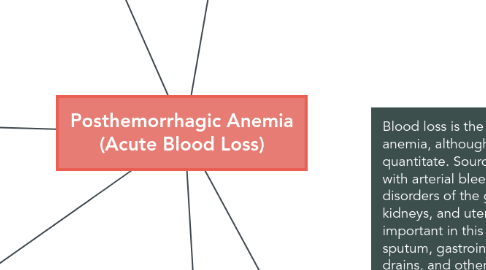
1. Definition: Anemia has been defined as a reduction in one or more of the major red blood cell (RBC) measurements obtained as a part of the complete blood count (CBC): hemoglobin concentration, hematocrit (HCT), or RBC count. In practice, however, a low hemoglobin concentration or a low hematocrit is most widely employed for this purpose (Schrier, 2018).
2. Normal values for red blood cell parameters in adults RBC parameter Men Women Hemoglobin, g/dL 15.7 (14.0 to 17.5) 13.8 (12.3 to 15.3) Hematocrit, percent 46 (42 to 50) 40 (36 to 45) RBC count, million/microL 5.2 (4.5 to 5.9) 4.6 (4.1 to 5.1) Reticulocyte count, cells/microL 20,000 to 110,000 20,000 to 110,000 Reticulocyte percentage 1.6 ± 0.5 1.4 ± 0.5 (Schrier, 2018).
3. Pathophysiology: Within 24 hours of blood loss, lost plasma is replaced by mobilizing water and electrolytes from tissues and interstitial spaces into the vascular system. Hemodilution will lower HCT value; concurrently, increase neutrophils and platelets. In severe blood loss, more immature cells and nucleated red blood cells enters the circulation. Reduction in tissue oxygenation stimulates production of erythropoietin and increasing production of erythrocytes in the bone marrow(Rote & MacCance, 2014).
4. Class I hemorrhage involves a blood volume loss of up to 15 percent. The heart rate is minimally elevated or normal, and there is no change in blood pressure, pulse pressure, or respiratory rate. Class II hemorrhage occurs when there is a 15 to 30 percent blood volume loss and is manifested clinically as tachycardia (heart rate of 100 to 120), tachypnea (respiratory rate of 20 to 24), and a decreased pulse pressure, although systolic blood pressure (SBP) changes minimally if at all. The skin may be cool and clammy, and capillary refill may be delayed. Class III hemorrhage involves a 30 to 40 percent blood volume loss, resulting in a significant drop in blood pressure and changes in mental status. Any hypotension (SBP less than 90 mmHg) or drop in blood pressure greater than 20 to 30 percent of the measurement at presentation is cause for concern. While diminished anxiety or pain may contribute to such a drop, the clinician must assume it is due to hemorrhage until proven otherwise. Heart rate (≥120 and thready) and respiratory rate are markedly elevated, while urine output is diminished. Capillary refill is delayed. Class IV hemorrhage involves more than 40 percent blood volume loss leading to significant depression in blood pressure and mental status. Most patients in Class IV shock are hypotensive (SBP less than 90 mmHg). Pulse pressure is narrowed (≤25 mmHg), and tachycardia is marked (>120 beats per minute). Urine output is minimal or absent. The skin is cold and pale, and capillary refill is delayed (Colwell, 2018).
5. A normal, healthy young adult can tolerate blood loss of 500 to 1000ml (10% - 20% of volume) without experiencing any symptoms. Losses up to 1500ml do not cause obvious symptoms if the individual is recumbent. Symptoms appear only when assuming an upright position. Blood loss >1500ml, symptoms are apparent even in a recumbent position. If blood loss exceeds 2000ml, severe shock and lactic acidosis, and death occur (Rote & McCance, 2014)
5.1. Symptoms will occur when the hemoglobin concentration falls below this level at rest, at higher hemoglobin concentrations during exertion, or when cardiac compensation is impaired because of underlying heart disease. The primary symptoms include exertional dyspnea, dyspnea at rest, varying degrees of fatigue, and signs and symptoms of the hyperdynamic state such as bounding pulses, palpitations, and a roaring pulsatile sound in the ears. More severe anemia may lead to lethargy, confusion, and potentially life-threatening complications such as congestive failure, angina, arrhythmia, and/or myocardial infarction (Schrier, 2018).
5.1.1. Hypovolemia – Anemia induced by acute bleeding is associated with the added complication of intracellular and extracellular volume depletion. The earliest symptoms include easy fatigability, lassitude, and muscle cramps. This can progress to postural dizziness, lethargy, syncope, and, in severe cases, persistent hypotension, shock, and death (Schrier, 2018)
6. Blood loss is the most common cause of anemia, although it is often difficult to quantitate. Sources include severe trauma with arterial bleeding at any site, and disorders of the gastrointestinal tract, lungs, kidneys, and uterus. The patient's history is important in this regard, as is testing of urine, sputum, gastrointestinal fluids, stool, surgical drains, and other bodily fluids for the presence of blood. There are a number of situations in which blood loss can occur and not be easily recognized. These include: Obvious bleeding (eg, trauma, melena, hematemesis, severe menometrorrhagia) . Occult bleeding (eg, slowly bleeding ulcer or carcinoma. Induced bleeding (eg, repeated diagnostic testing, hemodialysis losses, excessive blood donation) . Underappreciated menstrual blood loss (Schrier, 2018).
6.1. Treatment: Restoring blood volume by IV administration of saline, dextran, albumin and plasma. Large volume losses may require transfusion of fresh whole blood.
6.1.1. INITIAL MANAGEMENT OF HEMORRHAGE Control of external bleeding — Bleeding from external wounds must be controlled as rapidly as possible. Direct pressure is the primary method. Other methods used for hemorrhage control – such as tourniquets for extremity wounds and clips for scalp lacerations. The management of hemorrhage in the adult trauma patient will vary depending upon the known or suspected injuries, vital signs, extent of hemorrhage, available resources, and need for transfer. Nevertheless, a few key principles guide the management of hemorrhage due to trauma: Resuscitation using intravenous (IV) fluids should be used only for hypotensive patients, and then only until blood is available. Blood products should be given as soon as the need for transfusion is recognized. Blood products (ie, red blood cells, plasma [clotting factors], and platelets) should be given in equivalent amounts – in other words, in a 1:1:1 ratio. Thromboelastography, or comparable rapid point-of-care assessment of coagulation, should be used to guide trauma resuscitation whenever available (Colwell, 2018)
